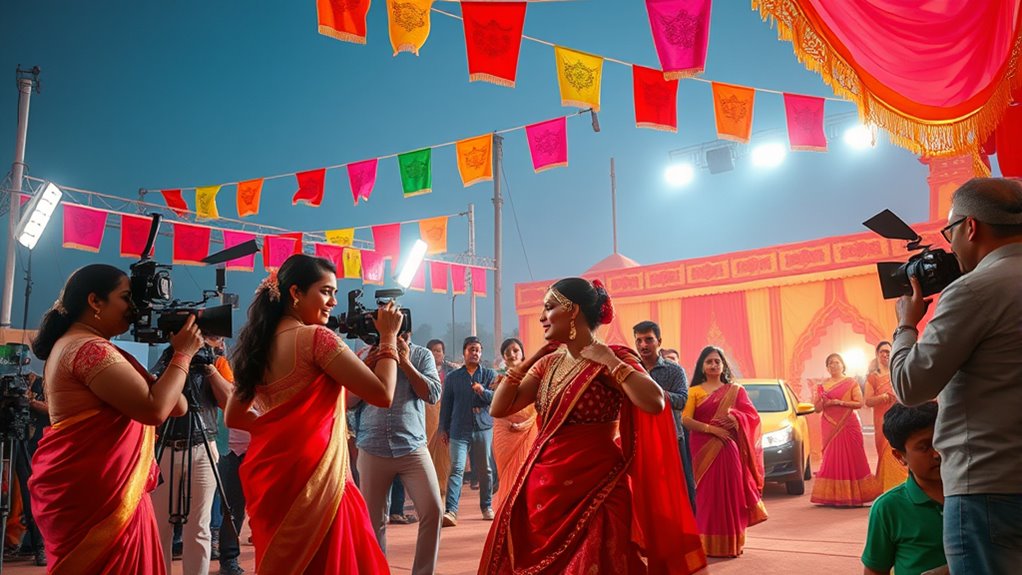South Indian cinema is revolutionizing India’s film scene by achieving massive pan-India success, which is changing audience tastes and industry standards. You’ll see stars like Prabhas and Allu Arjun dominating nationwide, prompting Bollywood to adapt with new genres, collaborations, and innovative marketing. distribution strategies also evolve to reach wider audiences. If you want to understand how this shift impacts Bollywood and future trends, there’s a lot more to uncover.
Key Takeaways
- South Indian films like *RRR* and *Kantara* achieve pan-India success, influencing Bollywood to adopt similar storytelling styles.
- Top South Indian stars now surpass Bollywood actors in popularity, prompting more collaborations and regional talent inclusion.
- Multilingual releases and dubbing break language barriers, expanding South Indian cinema’s reach across India and internationally.
- Industry collaborations, innovative marketing, and high-quality production set new standards that Bollywood increasingly adopts.
- The rise of streaming platforms enhances global accessibility, allowing South Indian films to reshape Indian film industry dynamics.
The Rise of South Indian Cinema in the Global Arena
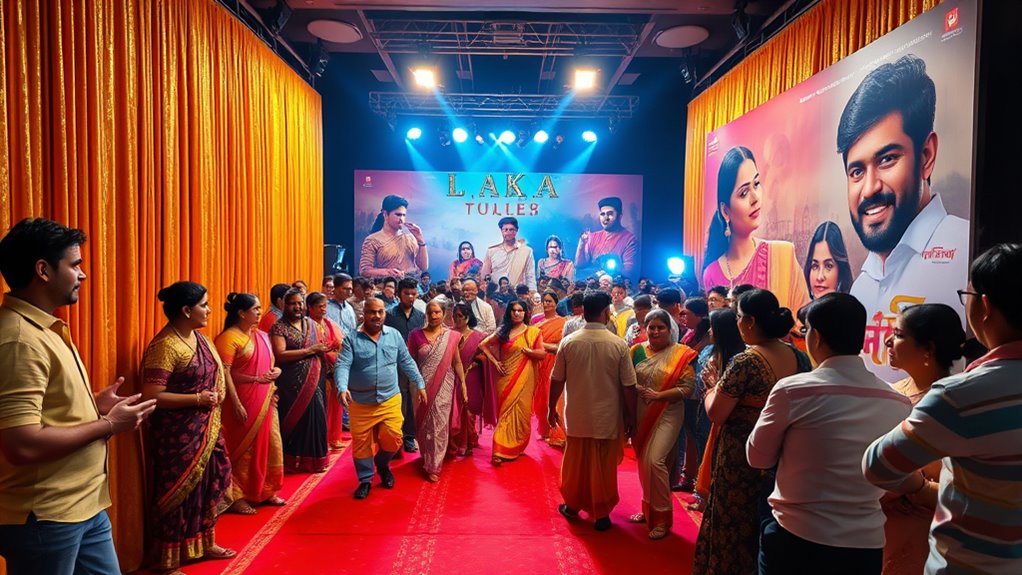
South Indian cinema is making a powerful mark on the global stage, driven by its increasing box office success and diverse storytelling. Films like *L2: Empuraan* have grossed over ₹268 crores worldwide, showcasing its international appeal. Blockbusters such as *Sankrathiki Vasthunam* have achieved ₹256 crores globally, proving South Indian films can dominate the global market. These movies often have budgets around ₹180 crores but generate returns exceeding ₹268 crores, highlighting their profitability. The overseas market is thriving too, with *L2: Empuraan* earning ₹142.25 crores outside India. Additionally, the rise of family-centric stories has contributed significantly to their widespread appeal. This success is partly fueled by innovative marketing strategies and digital distribution channels, which have expanded their reach beyond traditional audiences. South Indian cinema is exploring genres from action to comedy, broadening its reach and attracting diverse audiences worldwide. This expanding international footprint signals South Indian films’ rising influence and their challenge to traditional industry leaders. Additionally, the use of multilingual releases has helped these films cross linguistic barriers and reach a broader audience globally. Furthermore, the industry’s focus on cultural authenticity has resonated well with audiences both domestically and internationally, strengthening its global presence. The integration of technological innovations has also played a key role in enhancing production quality and audience engagement.
Shifting Audience Preferences and Cultural Roots
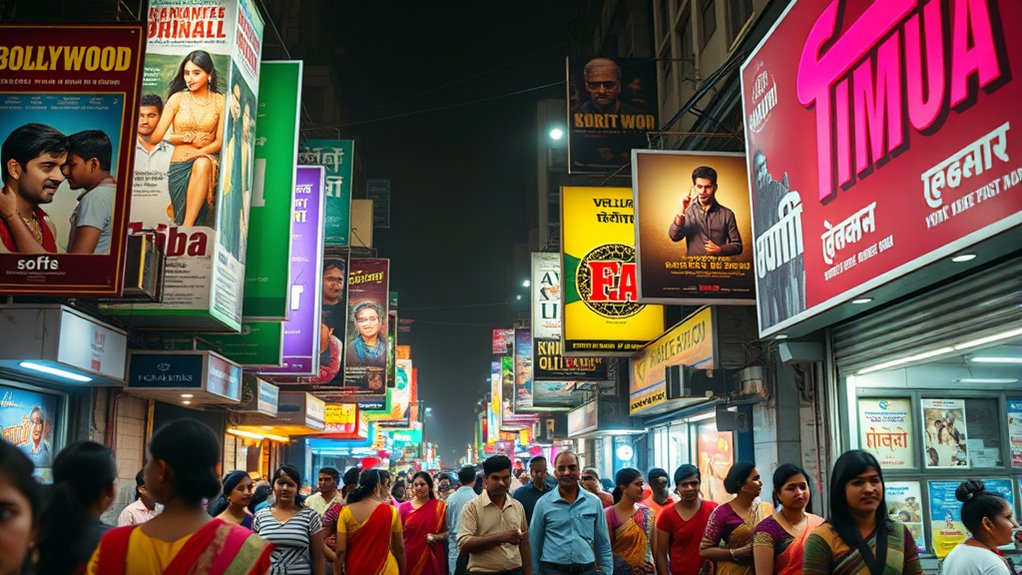
The increasing global success of South Indian films reflects a shift in audience preferences, as viewers seek out fresh and authentic storytelling experiences. You’re drawn to movies with unique storylines, diverse genres, and cultural authenticity that resonate on a deeper level. These films showcase local flavors, yet appeal broadly through collaborations and global recognition. They also adapt seamlessly to different cultural contexts, expanding their reach. Here’s a snapshot of how South Indian cinema aligns with audience tastes:
| Aspect | Impact |
|---|---|
| Unique Storylines | Attracts global viewers with innovative themes |
| Cultural Authenticity | Connects through genuine cultural expression |
| Diverse Genres | Offers something for every taste |
| Pan-India Reach | Expands availability across languages |
| International Appeal | Achieves worldwide success with hits like ‘RRR’ |
| Strategic Promotions | Enhance visibility and audience engagement across platforms |
Furthermore, the rise of digital distribution channels has significantly contributed to their global reach, enabling these films to find audiences far beyond traditional markets. This trend is also supported by the increasing presence of South Indian films at major international film festivals, which further amplifies their cultural influence. Additionally, the strategic use of market expansion strategies has helped these films break language barriers and reach diverse audiences worldwide. Moreover, the integration of innovative marketing techniques has amplified their market penetration, making them more accessible and appealing globally. The incorporation of advanced distribution channels ensures that these films can effectively penetrate new markets and adapt to changing viewer preferences.
How Bollywood Is Responding to New Market Realities
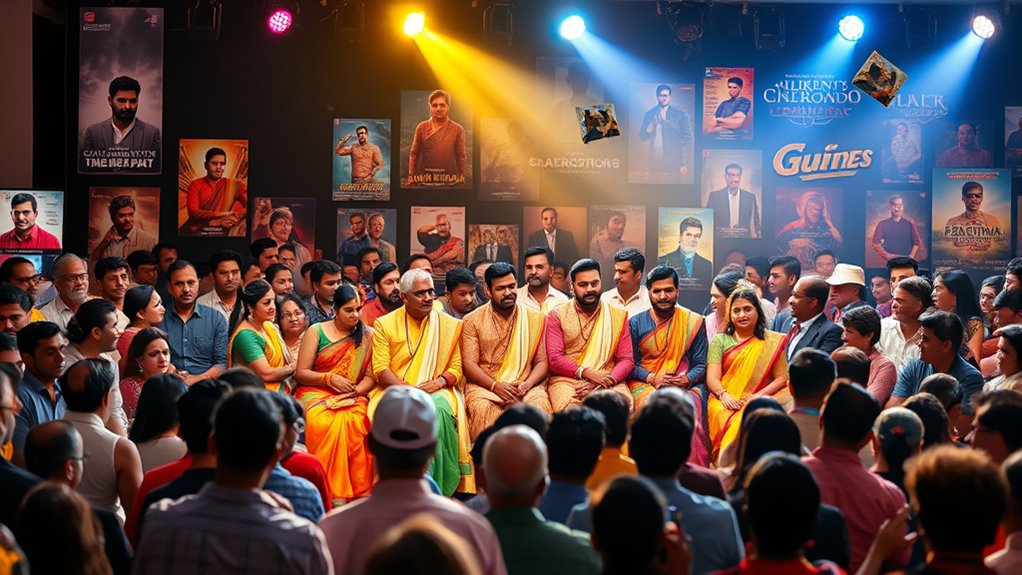
Bollywood is actively adapting to the evolving market landscape by shifting its focus toward high-energy action films and compelling biographical dramas, aiming to recapture audience interest and boost box office numbers. The industry is investing more in sequels and franchises like War 2 and Housefull 5, leveraging familiar stories to minimize risks and maintain engagement. There’s a clear emphasis on quality over quantity, with lower-budget hits like Uri demonstrating profitable strategies. To address challenges like soaring ticket prices and streaming competition, Bollywood is ramping up promotional efforts through social media, digital marketing, and brand collaborations. Technological advancements, including visual effects and digital distribution, are also being harnessed to enhance appeal and reach broader audiences. This strategic shift helps Bollywood navigate market pressures while staying competitive in a changing entertainment landscape, especially as regional South Indian cinemas, particularly Tamil films, have recovered robustly post-pandemic and are surpassing Bollywood in cinema attendance indicating audiences’ increasing preference for regional content. Additionally, the rise of regional cinema has introduced fresh narratives and styles that influence mainstream Bollywood productions. Moreover, understanding the importance of AI Security can provide insights into audience preferences and engagement strategies. Furthermore, the integration of geothermal heat pumps in building infrastructure can contribute to making cinema complexes more energy-efficient and environmentally sustainable, aligning with modern sustainability goals. In fact, the increased focus on sustainable and innovative technologies is also seen in the development of eco-friendly cinema complexes and energy-efficient building systems, which appeal to environmentally conscious audiences.
The Growing Influence of South Indian Stars in Bollywood

You’ll notice that South Indian stars like Prabhas, Vijay, and Allu Arjun now rank among India’s top actors, often surpassing Bollywood figures in popularity. Their massive fan bases and box office power are prompting Bollywood to spotlight more regional talent. As their influence grows, Bollywood’s content and marketing strategies are shifting to embrace this pan-India appeal. Additionally, the rising prominence of regional stars is fostering a self-awareness within the industry, encouraging creators to explore diverse narratives that resonate across audiences. This shift is also reflected in the increasing use of auras and regional cultural elements to connect with a broader demographic, further enriching the industry’s storytelling landscape. To facilitate this transition, many industry insiders are turning to capitalization styles to better communicate the evolving regional identities. The growing control of new regional stars over the market supply is also prompting a reevaluation of traditional Bollywood dominance. Moreover, this regional surge is prompting a cultural shift that influences not just casting choices but also storytelling themes across mainstream Indian cinema.
Cross-Industry Star Power
Have South Indian stars truly begun to reshape Bollywood’s landscape? Absolutely. You see, they’re now regularly cast in Hindi films, especially in action-packed, mass-entertainer roles, breaking regional barriers. Producers actively seek South talent for pan-India releases, and successful debuts by actors like Vijay Deverakonda and Rashmika Mandanna prove their rising influence. Collaborations between Bollywood and South industries are booming, with joint productions becoming common. South stars like Allu Arjun and Prabhas are achieving nationwide fame, drawing praise for their fresh performances that boost box office numbers. Hindi critics now appreciate South acting talent, and media coverage rivals Bollywood celebrities. This cross-industry star power not only elevates South actors’ profiles but also transforms Bollywood’s casting dynamics, making it more diverse and commercially driven. The increasing number of South Indian films crossing regional boundaries has further cemented their significant role in shaping Hindi cinema trends. Additionally, the casting of South stars in mainstream Bollywood films reflects a shift towards more inclusive and diverse storytelling that resonates across India. Moreover, the integration of South Indian cinema styles and narratives has influenced Bollywood’s evolving cinematic language.
Pan-India Star Appeal
South Indian stars are now commanding unprecedented popularity across India, reshaping the landscape of Indian cinema. You’ll notice actors like Prabhas, Vijay, Allu Arjun, Ram Charan, Mahesh Babu, and Jr NTR topping popularity charts, alongside Bollywood icons like Shah Rukh Khan and Salman Khan. Their success stems from innovative storytelling, high production values, and strategic marketing that connect deeply with audiences. These stars aren’t just regional favorites—they have global recognition, with South films gaining international acclaim. South stars like Rashmika Mandanna and Nayanthara are making successful Bollywood debuts, boosting their pan-India appeal. Their rising influence is evident in box office dominance, record-breaking fees, and widespread media coverage, signaling a shift where South Indian cinema now shapes Bollywood’s trends and future. Additionally, the increasing use of multimedia platforms has amplified their reach, further solidifying their position in the national and international markets.
Bollywood’s South Rise
The rise of South Indian cinema has considerably transformed Bollywood’s landscape, with films like *Baahubali* and *Pushpa* achieving remarkable pan-India success. You’ll notice South Indian stars like Prabhas and Allu Arjun becoming household names nationwide, thanks to their widespread popularity. Their films often outperform Bollywood blockbusters at the box office, boosting the industry’s revenue. Thanks to dubbing and subtitles, language barriers are breaking down, making these films accessible to a broader audience. Bollywood is now adopting South Indian storytelling styles, exploring new genres, and collaborating more with South Indian filmmakers. This shift is reshaping industry strategies, diversifying content, and elevating regional stars to national prominence. As South Indian cinema continues to grow, its influence is redefining Bollywood’s future.
Cross-Industry Collaborations and Creative Innovations
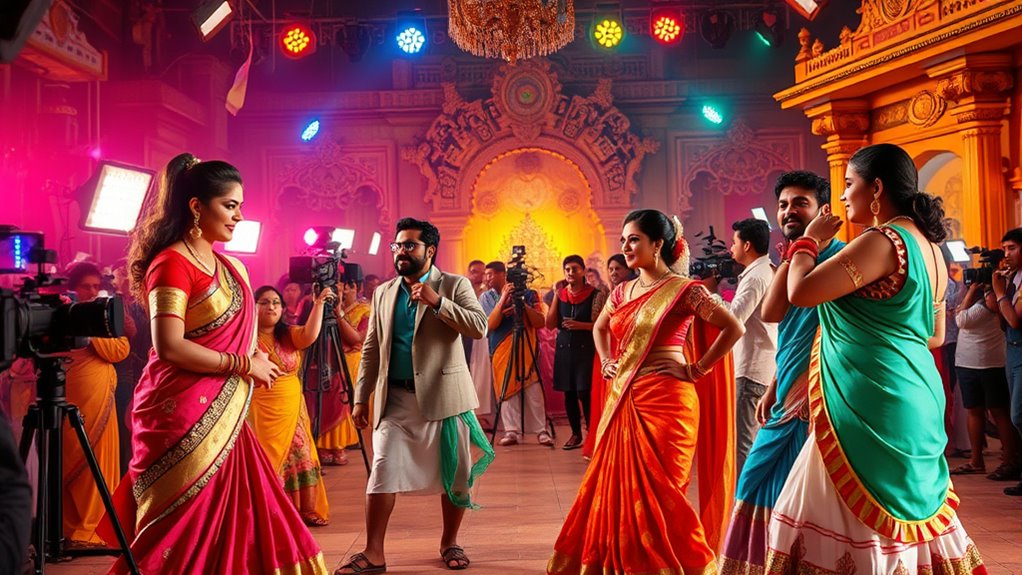
| Aspect | Examples | Impact |
|---|---|---|
| Joint Films | *RRR*, *Kantara* | Pan-India success |
| Genre Diversity | Historical, social dramas | Broader audience appeal |
| Technical Innovation | VFX, large-scale sets | Industry standards raised, with the adoption of advanced visual effects setting new benchmarks for production quality. |
| Multilingual Releases | *Salaar*, *Kantara* | Regional and national reach |
| Talent Exchange | Directors, actors, tech crew | Creative and technical growth |
| Market Dynamics | Increased regional collaboration | Audience engagement expands across demographics, fostering a multilingual industry ecosystem. |
Changing Distribution and Marketing Strategies
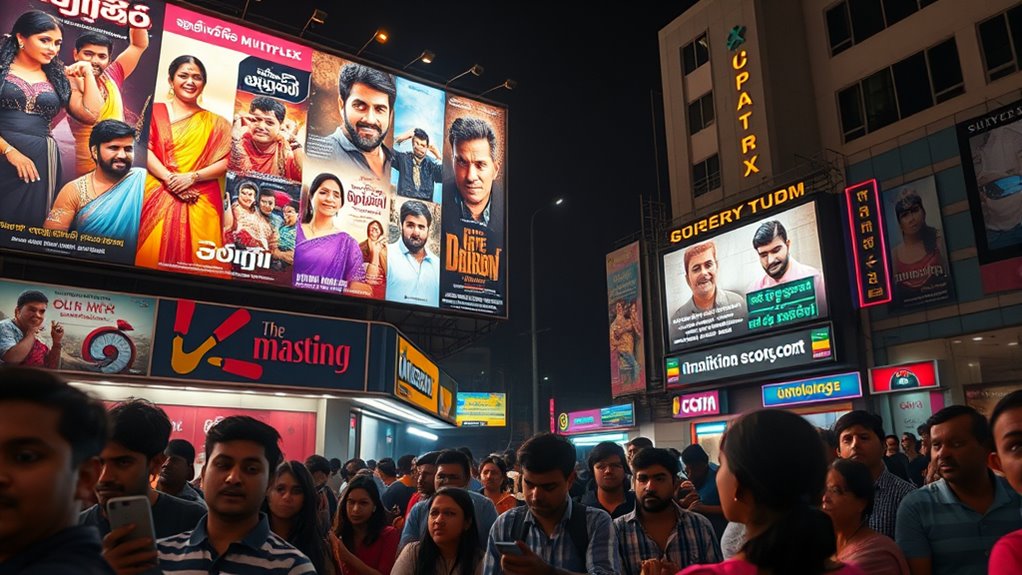
You notice how South Indian films are now carefully timing their theatrical and digital releases to maximize audience reach and revenue. They’re expanding distribution beyond traditional markets and creating multi-language campaigns to connect with diverse viewers. Streaming platforms and regional strategies are reshaping how films are marketed and accessed across India and globally.
Regional Release Strategies
As South Indian cinema gains prominence, filmmakers and distributors are reevaluating their release strategies to adapt to changing distribution and marketing landscapes. You’ll notice that traditional regional release plans often struggle in North India due to limited screenings and poorly timed launches. Instead, many films now prioritize OTT platforms over theatrical releases, which impacts the big-screen experience outside South India. You’ll also see a push toward diverse genres like horror, sci-fi, and historical epics, broadening audience appeal. The South Indian industry has shown resilience, recovering faster at the box office compared to Bollywood and Hollywood. However, the absence of big stars and planning missteps still affect profits, making strategic distribution and targeted marketing more essential than ever for regional success.
Multi-Language Campaigns
South Indian cinema’s innovative storytelling and strategic release plans have expanded their reach beyond regional borders, making multi-language campaigns a key tool in their marketing arsenal. These campaigns help films connect with diverse audiences worldwide, especially the Indian diaspora in the USA, Middle East, and Southeast Asia. By tailoring promotional strategies, they maximize impact and broaden box office potential. This approach leverages cultural resonance, appealing to both domestic and international viewers. The table below illustrates key elements of multi-language campaigns:
| Aspect | Focus Area | Impact |
|---|---|---|
| Innovative Storytelling | Diverse narratives | Attracts international audiences |
| Global Reach | Multi-language promotion | Expands audience base |
| Cultural Resonance | Audience engagement | Boosts box office and brand loyalty |
| Diaspora Influence | International markets | Strengthens global success |
Digital Distribution Expansion
Digital distribution has revolutionized how South Indian films reach audiences worldwide, making traditional methods nearly obsolete. You now benefit from streaming platforms like Netflix and Amazon Prime, which lower costs and expand global reach. This shift speeds up distribution by removing physical prints and customs delays, allowing films to go live faster. However, digital piracy remains a challenge, forcing industry players to continuously update security measures. The surge in investment in streaming services has created a sustainable model that balances blockbuster hits with diverse content. You can access films from anywhere, breaking geographical barriers and enabling South Indian cinema to compete globally. This expansion pushes the industry to adapt to new formats and channels, ensuring it stays competitive in an evolving digital landscape.
Future Outlook: Sustaining the Pan-India Boom
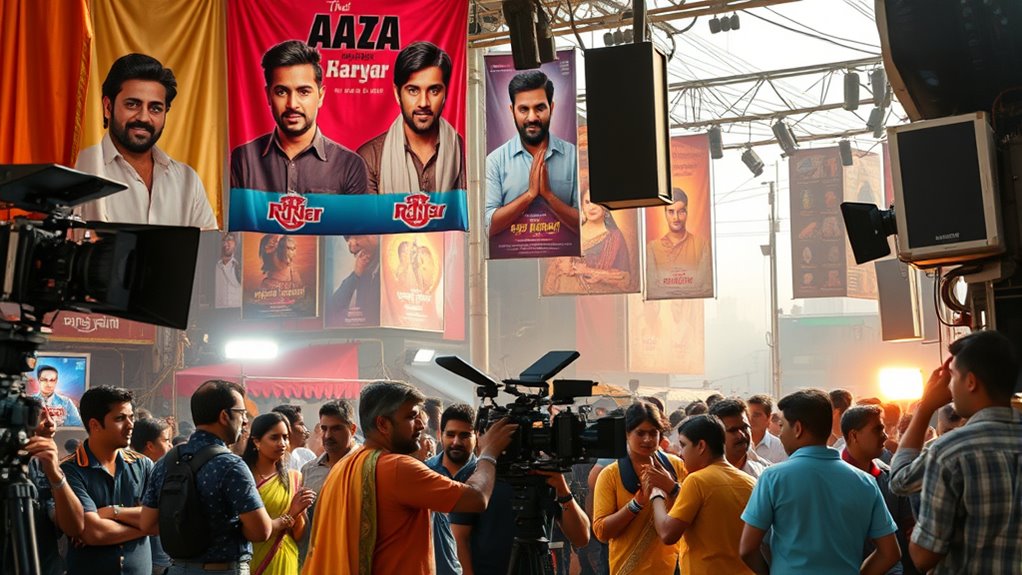
The momentum of South Indian cinema shows no signs of slowing down, thanks to its innovative storytelling, high production values, and strategic marketing efforts. You’ll notice films like ‘KGF’ and ‘RRR’ setting new standards for quality while connecting with diverse audiences locally and globally. To sustain this boom, filmmakers must continue investing in advanced technology, ensuring their stories stand out amid a crowded market. Collaborations between Bollywood and South Indian cinema can boost international reach and open new opportunities. Upcoming films with major stars and broader genre diversity will appeal to wider audiences, including the diaspora. Strategic marketing and pan-India releases will remain essential for maintaining growth. By evolving with audience preferences and leveraging global markets, South Indian cinema is poised to keep reshaping Indian film trends.
Frequently Asked Questions
What Specific Strategies Is Bollywood Adopting to Compete With South Indian Films?
You see Bollywood is adopting several strategies to compete with South Indian films. They’re expanding their global reach through digital platforms and international festivals, creating culturally resonant content, and investing in high-budget productions with diverse storylines. Bollywood also collaborates with South Indian filmmakers, avoids box office clashes, and leverages star power for promotional campaigns. These efforts help Bollywood stay relevant and attract wider audiences both in India and abroad.
How Are South Indian Actors Influencing Bollywood Casting Trends?
Imagine a river merging with a vast ocean—South Indian actors are doing just that in Bollywood. Their success and versatility inspire you to contemplate a broader pool of talent, expanding casting choices. Their rising popularity is reshaping Bollywood trends, pushing the industry toward more diverse and inclusive projects. You see it in cross-industry collaborations and pan-India films that appeal to wider audiences, changing the very fabric of Bollywood casting.
What New Genres Are Emerging From Bollywood and South Indian Cinema Collaborations?
You notice new genres emerging from Bollywood and South Indian collaborations, blending styles creatively. Political thrillers now combine intense drama with socio-political themes, appealing to wider audiences. Action and crime dramas feature high-octane sequences and social issues, while hybrid genres mix thriller, drama, and masala elements inspired by South Indian filmmaking. Romantic and social narratives also evolve, incorporating regional nuances and contemporary themes, making films more authentic and engaging for diverse viewers across India.
How Are Distribution Channels Changing to Accommodate the Pan-India Market?
You might find it surprising that South Indian films now generate more revenue than Bollywood in some years. Distribution channels are evolving quickly to meet this shift. You’ll see a mix of traditional theatrical releases and digital platforms, reaching audiences across India and globally. Streaming services and digital marketing boost reach, while elaborate fan events help promote films worldwide. This dynamic approach helps South Indian cinema expand its influence and capture new markets effectively.
What Challenges Does Bollywood Face in Maintaining Its Traditional Audience Base?
You’re facing the challenge of retaining your traditional audience as their entertainment preferences shift. The decline in theater attendance, especially in smaller towns, and the rise of live events and digital streaming pull viewers away. Additionally, audiences now see South Indian films as more original and engaging, making it harder for Bollywood to compete. To stay relevant, you need to innovate content, distribution, and marketing strategies to reconnect with your core viewers.
Conclusion
As South Indian cinema continues its impressive rise, you might wonder if Bollywood can truly adapt. But by embracing new storytelling styles, star power, and innovative marketing, Bollywood isn’t just reacting—it’s evolving. This shift isn’t about replacing traditions; it’s about enriching them. So, despite concerns of cultural dilution, the pan-India boom signals a vibrant, collaborative future where all regional cinemas thrive together, shaping India’s cinematic landscape for years to come.
